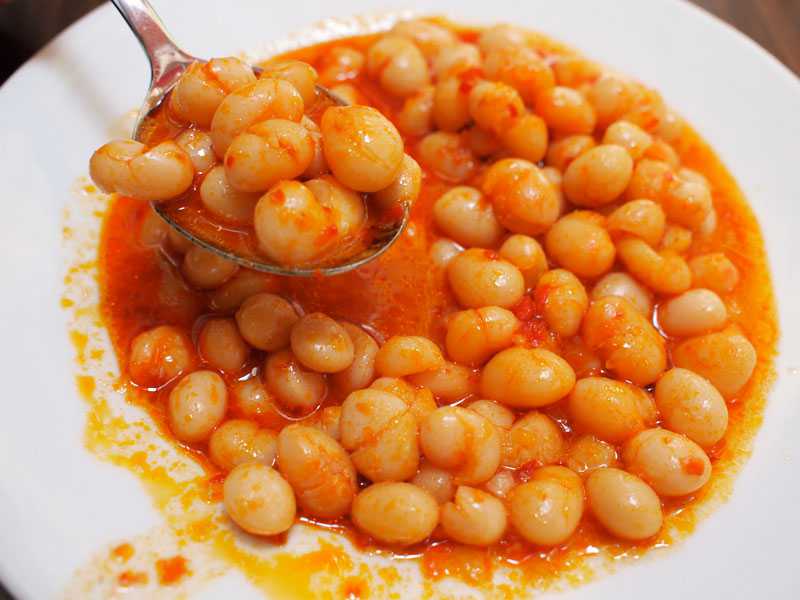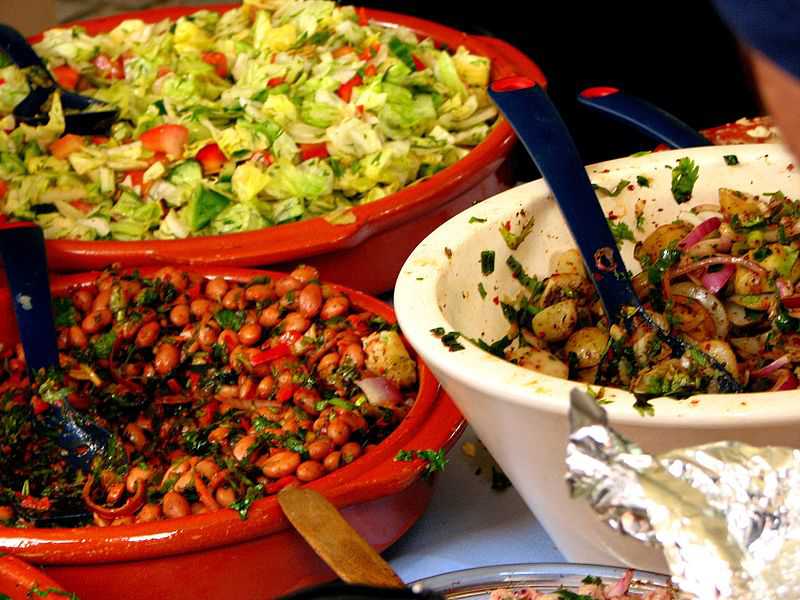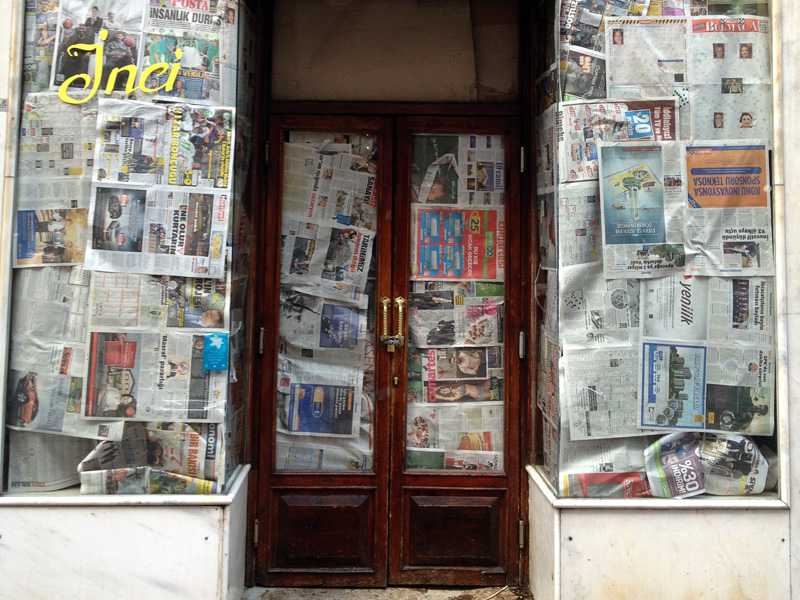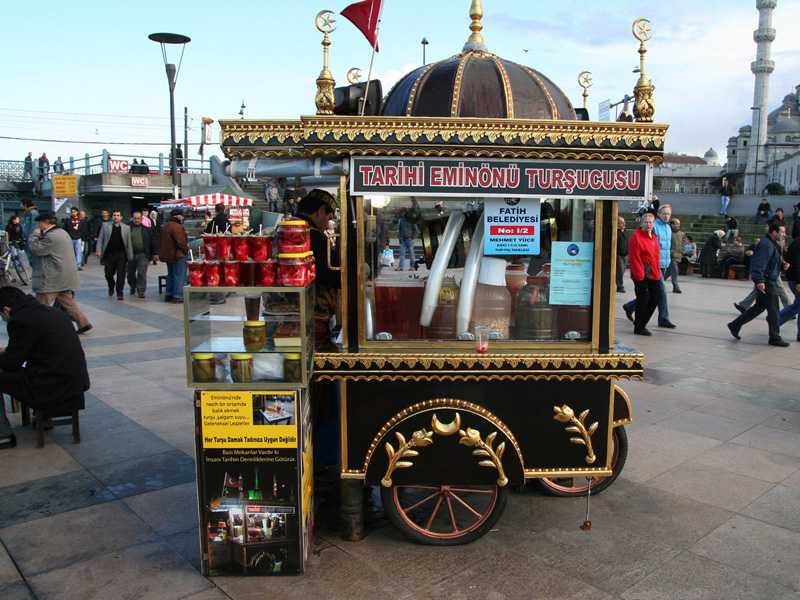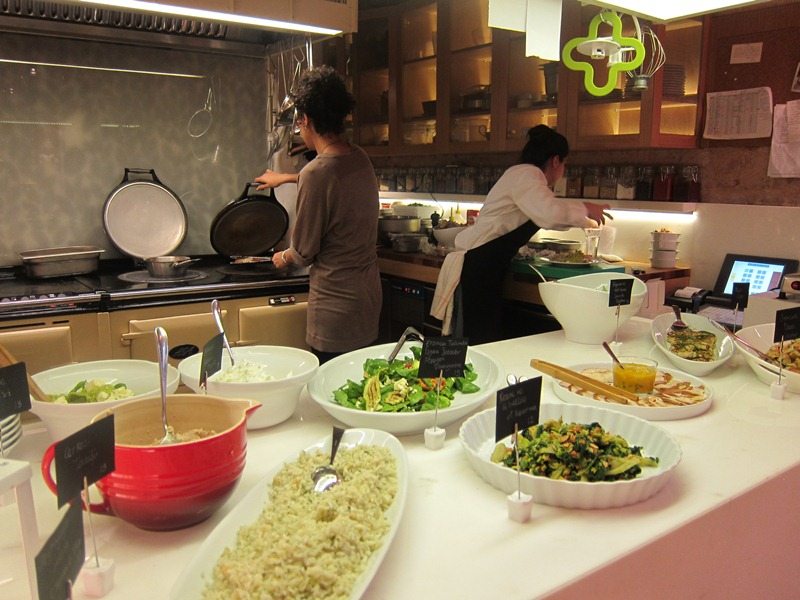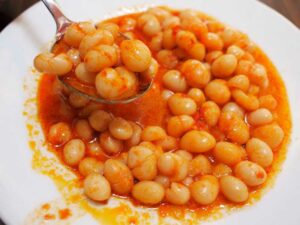 Until we visited some of Istanbul’s shrines to the baked bean, we generally regarded the dish as something eaten out of a can beside railroad tracks. But Turkey takes this humble food, known as kuru fasulye, seriously; that means chefs in tall toques carefully ladling out golden beans in a rich red gravy onto monogrammed flatware, served by waiters wearing bowties and vests. Even in the least formal of Istanbul’s beaneries, the guy manning the pot has the air of a high priest who knows that his incantations alone conjure something unusually delicious out of a simple dry white legume. This is no hobo fare.
Until we visited some of Istanbul’s shrines to the baked bean, we generally regarded the dish as something eaten out of a can beside railroad tracks. But Turkey takes this humble food, known as kuru fasulye, seriously; that means chefs in tall toques carefully ladling out golden beans in a rich red gravy onto monogrammed flatware, served by waiters wearing bowties and vests. Even in the least formal of Istanbul’s beaneries, the guy manning the pot has the air of a high priest who knows that his incantations alone conjure something unusually delicious out of a simple dry white legume. This is no hobo fare.
There are two general schools of bean cooking in Turkey: Black Sea and Anatolian. Beans Black Sea-style sit in a red gravy so thick with butter and laden with chunks of meat that we eat it with a fork and a hearty piece of bread. Anatolian beans, often known as Erzincan beans, are soupier and cooked in a tomato-based sauce without butter and meat. Either way, you can’t go wrong.
The following are our top five bean joints in town:
#1, Hanımeli
The far-flung district of Gaziosmanpaşa might sound like a long distance to travel for a plate of beans, but we’d already tried all of the big-name beans in this city. Selma Usta, who stakes her claim as the only female kuru fasulye master in Istanbul, had no poufy hat and starched white jacket, nor – the pride of most bean masters – a giant copper pot. But don’t be fooled by the looks of this humble little beanery in a drab suburb. It has a fanatical following.
And the beans were all that. Selma Usta prepares the plump and pale Erzincan variety in tiny batches with materials she sources personally from the city of Tokat, in the heart of Anatolia. She claimed to be holding some secrets, and we believe her. But for us, the defining feature of the dish was the butter, which was like nothing we’d encountered in Turkey. Selma’s farm-fresh Tokat butter gave the dish a strong flavor and filled the dining room with its intoxicating musk. This superior ingredient, like a rocket booster, shot the dish beyond the realm of worldly beans to where it now floats – in our minds at least – in bean heaven.
Address: 1028. Sokak 4, Gaziosmanpaşa (near the Taşköprü stop on the T4 metro line)Telephone: +90 212 477 1706 Web: Hours: 8am-8pm; closed Sunday
#2, Fasuli Lokantası
The beans at Fasuli Lokantası glow unbelievably orange, as if the chef slipped a little something radioactive in the pot. Whatever the recipe, these beans are among the best we’ve had in Istanbul. Stiffened by a whole lot of butter, the gravy and beans achieve almost the same creamy consistency. The cool, crisp raw onions and pickled hot peppers are a welcome balance to the richness of the dish, although their aroma stays with you long after your meal. Host to a loyal lunch crowd, this white-tablecloth establishment also serves up other Black Sea specialties, including muhlama (a sort of Turkish fondue), stuffed chard leaves and corn bread. The location, across the street from Tophane’s nargile cafés and near the Karaköy waterfront, is an added bonus.
Telephone: +90 212 243 6580 Web: http://www.fasuli.com.tr/ Hours: 11am-11pm
#3, Hüsrev
A severe man in a monogrammed blazer stands at the door to Hüsrev, greeting important patrons who walk in and check their coats without pausing from their telephone conversations. Eavesdrop and you’ll probably overhear major business deals being closed. It’s easy to get so caught up in the charged atmosphere that you forget that everyone has ordered nothing more than a bowl of beans accompanied by a salty yogurt drink. But that’s what’s so pleasurable about Hüsrev, which calls itself the “world’s bean gentleman.” From Hong Kong to Houston, a high-powered business lunch is propelled by a big steak and stiff drinks, but here, deals are sealed over beans.
The blond and creamy beans, bathed in a rich, red gravy, are certainly worthy of their dedicated following. We got the feeling that every variable in the recipe is tightly controlled by a board of ustas in white coats. With such resources, how could these not be the best beans in Turkey? Indeed, though we could not identify a single flaw, we were a little disappointed to find them only delicious. We were hoping for magic beans that would transform us into rich and successful people like everyone else at Hüsrev. But even though they were the most expensive beans we’d ever eaten, we weren’t that much poorer leaving the place.
Address: Dedeman İş Merkezi, Yıldız Posta Caddesi 48/1, Esentepe (located next to Dedeman Hotel in Gayrettepe)Telephone: +90 212 347 4210 Web: http://www.husrev.com.tr Hours: 11am-9:30pm
#4, Çömlek
You can’t miss the huge, red clay cauldron sitting behind the counter at Çömlek. The fellow with the big ladle says it’s the pot that makes these beans better than the rest. Cooking vessel aside, a serving of these beans also has the highest meat count of any we’ve tasted in Istanbul. Whereas most beans might have a shred or at best a few nuggets of tender roasted beef in there for flavor, Çömlek’s are crowned with a generous helping of meat. In such a rich dish the meat satisfyingly offsets the cloying beans, leaving the meek still able to walk away and the strong-willed able to order up another half portion. The restaurant, located on the wooded slopes above Üsküdar on the Asian side, is a bit out of the way. But for us, these are beans at their best and worth the trip.
Telephone: +90 216 316 2953 Web: Hours: 11am-11pm
#5, Erzincanlı Ali Baba
According to historians, Tiryaki Sokak (“Addicts’ Alley”) got its name from the opium served up in its coffeehouses during Ottoman times. Though that substance has long been banned, since 1924 Ali Baba has been ladling out something equally addictive from a great copper pot: Erzincan-style baked beans. Ingredients such as onion, tomato and chili pepper are more recognizable in the soupy base, as the bean is bigger than its Black Sea counterpart. Though we remain junkies of the Black Sea variety, the Erzincan preparation is a nice change of pace and there’s no better place to try a bowl than sitting on Ali Baba’s squat stools in the shadow of the minarets of the sublime Süleymaniye Mosque.
Telephone: +90 212 513 6219 Web: http://www.kurufasulyeci.com/ Hours: 11am-9pm (top photo by Yigal Schleifer; bottom three photos by Ansel Mullins)

